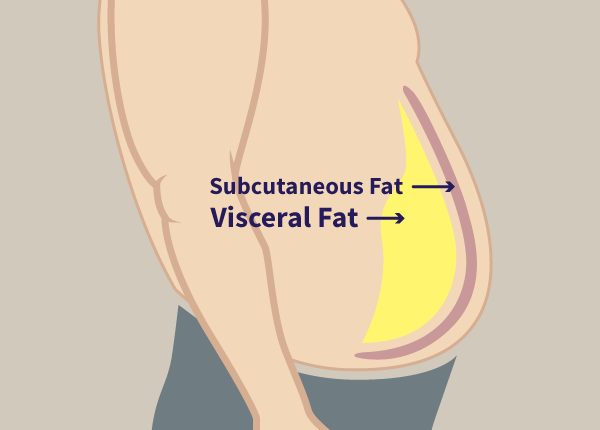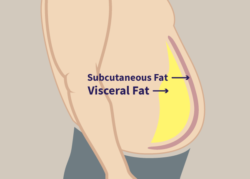
Most American Human Bodies Carry Excess Fat!
Let’s Learn About Stored Body Fat
 It seems pretty obvious that fat is a fuel storage that accumulates on our bodies in response to hormonal signaling from insulin, as well as many other factors. Unfortunately, we can say that MOST Americans have excess fat stores on their body that are most likely not going to serve the body very well. I love the work at I do with the HCG DIET WEIGHT LOSS METHOD to help patients lose excess fat stores.
It seems pretty obvious that fat is a fuel storage that accumulates on our bodies in response to hormonal signaling from insulin, as well as many other factors. Unfortunately, we can say that MOST Americans have excess fat stores on their body that are most likely not going to serve the body very well. I love the work at I do with the HCG DIET WEIGHT LOSS METHOD to help patients lose excess fat stores.
Many moons ago, it was important for the body to store fat in the presence of a food abundance; as this fat was a fuel source that would serve us when food was scarce. The problem with our human genetics today is that we are programmed to store fat in the abundance of food but we rarely run into the situation where we are without food to use the fat we stored as fuel.
The Physiology of Fat
Body fat, which is also called adipose tissue, is made up of three unique types of fat cells:
- white fat
- brown fat
- beige fat
White Fat
White fat is the dominant form of fat in the body. Composed of a single lipid droplet, and few blood vessels, this fat gets its name from its white/yellow hue. White fat increases when we consume too many calories and do not move enough in our bodies! This type of fat accumulates in the hips, thighs, buttocks, and abdomen.
Brown Fat
Brown fat is named for its darker, brownish appearance. This form of fat contains several lipid droplets and some iron-containing cells that burn energy. Sometimes, brown fat is known as the “good fat.”
Brown fat tends to be in the neck and upper back and is associated with a youth and vitality. It is interesting to know that with good exercise, deep sleep and cool temperatures some white fat can be converted into brown fat. This is what we actually call “beige fat.”
The Storage of Body Fat
Within the body, fat cells can be found in different areas with different jobs and levels of danger. Subcutaneous and visceral fat are the main fat stores in the body. These types of fat have unique properties and functions in our bodies.
Essential Fat
Essential fat plays a significant role in overall health and and truly is essential for survival. That is why a goal of very low percent body fat is neither realistic nor healthy. We need fat on our bodies to live optimally
Essential fat is present in organs, bone marrow, nerve cells, and the brain, and helps us to maintain energy reserves by acting as a metabolic fuel. This kind of fat also helps us to conserve body heat by acting as an insulator. Essential fat will also protect the internal organs and joints by acting as a cushion. We also can make a connection between adequate essential fat stores and fertility. Hormones do not work as well when essential fat stores in the body are too low.
On our InBody body composition analyzer, we find essential fat to be optimal at around 3% for men and 8-12% for women. Women require more essential fat due to the role fat plays in reproductive functions.
Storage Fat
Storage fat is not essential for the body. This is the fat that accumulates as energy reserves. Storage fat affects body shape and appearance. Storage fat has 2 forms known as:
- subcutaneous fat
- visceral fat
Both subcutaneous and visceral fat are storage forms of fat that are uniquely different in many ways.
Storage Fat: Subcutaneous Fat
This fat is found just underneath the skin. Subcutaneous fat is a fat tissue that you can see, touch, and pinch. Subcutaneous fat is the type of body fat that most people think of when they hear the word “fat” because it is what bothers them.
Excess subcutaneous fat can create a variety of health risks but visceral fat, the second type of storage fat, has a greater potential to be a lot more harmful!
Visceral Fat
Visceral fat is the body fat that surrounds your organs in your abdomen. These fat cells hide between your organs and become overlooked when you use BMI to assess health or body density measurements. Visceral fat is a far more dangerous health threat than subcutaneous fat, and it’s become an independent predictor of mortality in men and women.
High levels of visceral fat which can be hard-to-see fat, can be a true red flag for overall health. Visceral fat creates inflammatory proteins that can stress the body, causing damage to many-body systems. This can lead to serious diseases such as cardiovascular disease, liver disease, diabetes, and other life-threatening conditions. In some cases, a person may not appear overweight but the visceral fat accumulates internally and creates “metabolic issues.” This fat is associated with type 2 diabetes, heart disease and stroke.
Tags: best hcg diet portland, Body Composition Analysis, Body Fat, Eating Healthy, Fat Loss Portland, HCG Diet and Exercise, HCG Diet Beaverton, HCG Diet Cleanse, hcg diet doctor, HCG Diet Food Info, HCG Diet Gresham, HCG DIet Intermittent fasting Portland, HCG Diet Lake OSwego, HCG DIET NW Portland, HCG Diet Portland Oregon, hcg diet program, HCG Diet Recipe, hcg diet SE Portland, Healthy Diet Doctor Portland, medical HCG Diet program, The Danger of Fat, What is fat?
Categories: AOD weight loss, Body Composition, Eating Well, General Wellness, HCG Diet Weight Loss, Lipotropic injections, medical weight loss, Weight Loss
